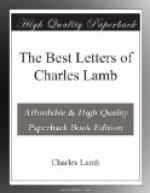The “Tales from Shakspeare,” by Charles and Mary Lamb, were published by Godwin in 1807, and a second edition was called for in the following year. Lamb was now getting on surer—and more remunerative—ground; and in 1808 he prepared for the firm of Longmans his masterly “Specimens of the English Dramatic Poets contemporary with Shakspeare.” Concerning this work he wrote to Manning:—
“Specimens are becoming fashionable. We have Specimens of Ancient English Poets, Specimens of Modern English Poets, Specimens of Ancient English Prose Writers, without end. They used to be called ‘Beauties.’ You have seen Beauties of Shakspeare? so have many people that never saw any beauties in Shakspeare,”
From Charles Lamb’s “Specimens” dates, as we know, the revival of the study of the old English dramatists other than Shakespeare. He was the first to call attention to the neglected beauties of those great Elizabethans, Webster, Marlowe, Ford, Dekker, Massinger,—no longer accounted mere “mushrooms that sprang up in a ring under the great oak of Arden.” [12]
The opportunity that was to call forth Lamb’s special faculty in authorship came late in life. In January, 1820, Baldwin, Cradock, and Joy, the publishers, brought out the first number of a new monthly journal under the name of an earlier and extinct periodical, the “London Magazine,” and in the August number appeared an article, “Recollections of the South Sea House.” over the signature Elia. [13] With this delightful sketch the essayist Elia may be said to have been born. In none of Lamb’s previous writings had there been, more than a hint of that unique vein,—wise, playful, tender, fantastic, “everything by starts, and nothing long,” exhibited with a felicity of phrase certainly unexcelled in English prose literature,—that we associate with his name. The careful reader of the Letters cannot fail to note that it is there that Lamb’s peculiar quality in authorship is first manifest. There is a letter to Southey, written as early as 1798, that has the true Elia ring. [14] With the “London Magazine,” which was discontinued in 1826.
Elia was born, and with it he may be said to have died,—although some of his later contributions to the “New Monthly” [15] and to the “Englishman’s Magazine” were included in the “Last Essays of Elia,” collected and published in 1833. The first series of Lamb’s essays under the title of Elia had been published in a single volume by Taylor and Hessey, of the “London Magazine,” in 1823.
The story of Lamb’s working life—latterly an uneventful one, broken chiefly by changes of abode and by the yearly holiday jaunts, “migrations from the blue bed to the brown”—from 1796, when the correspondence with Coleridge begins, is told in the letters. For thirty-three years he served the East India Company, and he served it faithfully and steadily. There is, indeed, a tradition that having been reproved on one occasion for coming to the office late in the morning, he pleaded that he always left it “so very early in the evening.” Poets, we know, often “heard the chimes at midnight” in Elia’s day, and the plea has certainly a most Lamb-like ring. That the Company’s directors, however, were more than content with the service of their literate clerk, the sequel shows.




